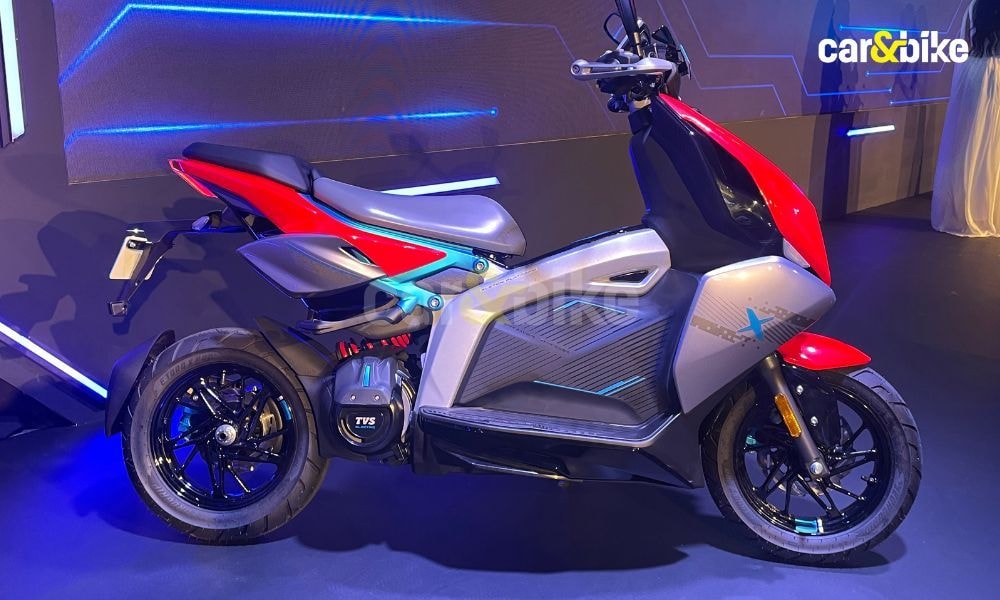Why the TVS X May Be Doing Other Electric Scooters A Favour: Opinion

- At Rs 2.50 lakh, the X is the second most expensive model in TVS’ entire two-wheeler line-up.
- On paper, the X struggles to distinguish itself from current crop of e-scooters when it comes to range, battery, charge times.
- At anywhere between Rs 80,000 to Rs 1 lakh less, premium models from other electric two-wheeler firms offer better perceived value.
Given the steady (but focused) build-up with its #AtTheTop pre-launch campaign, it was only expected that TVS’ brand-new electric two-wheeler would be its flagship battery-powered offering. Expectations were high for TVS to deliver a model that would blow the competition out of the water and carve a new path at the premium end for the market. In the end, even higher than said expectations turned out to be the introductory price of the just-launched TVS X, which costs Rs 2.50 lakh (ex-showroom).
Also Read: TVS X Electric Scooter Launched At Rs 2.50 Lakh; Has 140 KM Range, 105 Kmph Top Speed
The TVS X was launched with much fanfare, in Dubai, on August 23.
Gone are the days when India was an incredibly price-sensitive market. Legacy players, along with start-ups, have gradually shown there is a market for scooters that cost more than Rs 1 lakh, and in quite a few cases, even above Rs 1.50 lakh. This is also a price point currently occupied by the flagship offerings of most electric two-wheeler manufacturers such as Ola Electric, Ather Energy and Simple Energy. Models that shatter the perceived price ceiling are still rare today, but they do exist – the Ultraviolette F77 is one such creation. At Rs 3.80 lakh to Rs 4.55 lakh, the F77 is genuinely expensive, and from a price point of view, is steering gingerly through uncharted waters.
Also Read: TVS X Electric Scooter: All You Need To Know
The TVS X's pricing ensures it cannot qualify for central or state subsidies.
In the F77’s case, the price seems justifiable because there is no other electric motorcycle in India today that is anything like it. The F77 is unrivalled when it comes to battery capacity (7.1 kWh and 10.3 kWh) and range (up to 307 km IDC), and also on power and performance. It’s not affordable and will never be a mass product, but it breaks enough new ground to command the value its maker has bestowed it with. Unfortunately, the same doesn’t seem to be the case with the TVS X.
Given its new-for-the-segment form factor, there is definitely an element of novelty to the X. With an aluminium alloy frame (and a cast rear subframe), the X has a moto-scooter-like form, with the raised central spine also housing the charging port on top. But as much as TVS would like for it to be seen as a ‘crossover’, the X is still very much a scooter. And it’s the most expensive electric scooter on sale in the country by a country mile, on top of being the second most expensive two-wheeler in TVS’ current line-up; second only to the Apache RR 310.
All-new, EV-oriented ‘Xleton’ platform utilises an aluminium alloy frame, which adds to the cost.
At this price, it would be pertinent to expect the X to have the biggest battery of any electric scooter in India. But it doesn’t – with a 4.4 kWh installed capacity, it’s second to the Simple One (5 kWh), and only marginally higher than the Ola S1 Pro (4 kWh). It’s a different matter that the availability of the One is in itself a question mark, with just 36 units registered till date according to VAHAN data. Sources say TVS opted for this battery size to ensure costs didn’t spiral out of control.
The X’s mid-mounted motor does have an impressive continuous output of 7 kW, but its peak output of 11 kW is on par with the S1 Pro Gen 2’s, along with the 0-40 kmph acceleration time (2.6 sec). Its 105 kmph top speed is again lower than the Ola’s (120 kmph), but the most vital stat is the range. TVS says the X has a certified range of up to 140 kilometres. This is lower than the Ather 450X 3.7 kWh (150 km) and much lower than the S1 Pro G2 (195 km). And the X doesn’t seem terribly practical either, with its 19-litre underseat storage being smaller than that of even the Ather (22 litres), and much more restricted than the Ola (34 litres). Viewed purely from a spec point of view, the X seems a touch underwhelming.
Also Read: TVS X vs Rivals: Specifications Comparison
The Ola S1 Pro Gen 2 claims to match the TVS X on power and performance, and better it on range and top speed.
Aside from the impressive frame, the X also has the largest touchscreen (10.25 inches) seen on any electric two-wheeler in India till date, cornering lights and selectable regen modes. Home fast charging, with an optional 3 kW charger, is another strong point. Encouragingly, TVS says it developed the X's motor and battery management system (BMS) in-house, which bodes well for future products. It also has another e-scooter first in the form of an anti-lock braking system (ABS), but it is a single-channel setup, and not dual-channel, like you’d expect from a product billed to deliver unbridled performance.
A key innovation with the TVS X is the option of a 3 kW home fast-charger.
At this price, the X is not eligible for any kind of central or state subsidy, and this isn’t an all-inclusive price – you shell out over Rs 16,000 extra for the portable 950-watt charger (which is compulsory), and even more if you want the faster 3 kW home charger. Taxes included, the X is likely to cost a chunky Rs 3 lakh. Not only does this price tag make the X look like a TVS tech showcase built for those seeking exclusivity, but also makes other premium e-scooters look like great value.
Rivals such as Ather Energy have a fully functional public fast-charging network to offer as added value.
Despite a recent price hike following a reduction in FAME-II subsidy, the likes of the Ather 450X 3.7 kWh, Ola S1 Pro and Simple One are anywhere between Rs 80,000 to Rs 1 lakh cheaper. The comparatively more accessible prices do not come with massive trade-offs. The 450X remains as exciting and quick a scooter as any, even with a lower top speed, and can tap into a functional fast-charging public network. The S1 Pro Gen 2 packs in the most for the least amount of money in this category, and even with inconsistent and unsavoury customer experiences with the start-up, continues to find buyers in droves. Even if the subsidies disappear (and it’s likely to happen pretty soon), there will still be a yawning gap in the prices of the X and other e-scooters.
For those seeking a path-breaking E2W, the base F77 costs roughly Rs 1 lakh more than the X, and offers far more performance and range.
Today, Rs 3 lakh can buy you a pretty exciting two-wheeler if you’re not fussed about body style or powertrain. The recently-launched Triumph Speed 400 and Harley-Davidson X440 have drawn a huge crowd to this price bracket. Even for someone wanting an electric two-wheeler that’s path-breaking, there exists the base F77, which packs far more power and range than the X for about Rs 1 lakh more, and offers exclusivity as standard.
It’s almost certain that the X, being a TVS, will bring impressive performance and on-road dynamics to the table, which we will get to experience first-hand pretty soon. I just can’t help shake off the feeling that the X is more of a statement of intent from TVS – and possibly a great opening salvo for export markets – than it is a true game-changer for electric two-wheeler buyers in India.
Trending News
Latest News
 Janak Sorap | Dec 16, 2025Yamaha R3 and MT-03 Discontinued in India; Here’s WhyThe motorcycles had revied around a price revision of more than a lakh earlier this year, followed by additional discounts due to GST reform, and yet have failed to secure any momentum.1 min read
Janak Sorap | Dec 16, 2025Yamaha R3 and MT-03 Discontinued in India; Here’s WhyThe motorcycles had revied around a price revision of more than a lakh earlier this year, followed by additional discounts due to GST reform, and yet have failed to secure any momentum.1 min read Jaiveer Mehra | Dec 15, 2025Mahindra XUV 7XO Interior Previewed Ahead Of Debut; Triple Screen Layout ConfirmedNew teaser video provides a glimpse at the facelift XUV 700’s cabin and confirms some of the features.1 min read
Jaiveer Mehra | Dec 15, 2025Mahindra XUV 7XO Interior Previewed Ahead Of Debut; Triple Screen Layout ConfirmedNew teaser video provides a glimpse at the facelift XUV 700’s cabin and confirms some of the features.1 min read Jaiveer Mehra | Dec 15, 20252026 MG Hector Facelift Launched At Rs 11.99 LakhThe latest facelift of MG’s SUV brings tweaks to the styling and cabin, along with a few new features.3 mins read
Jaiveer Mehra | Dec 15, 20252026 MG Hector Facelift Launched At Rs 11.99 LakhThe latest facelift of MG’s SUV brings tweaks to the styling and cabin, along with a few new features.3 mins read car&bike Team | Dec 14, 2025Top-Spec Tata Sierra Accomplished, Accomplished+ Prices RevealedRegardless of the powertrain combination chosen, all Tata Sierra Accomplished+ trims cost upwards of Rs 20 lakh (ex-showroom).2 mins read
car&bike Team | Dec 14, 2025Top-Spec Tata Sierra Accomplished, Accomplished+ Prices RevealedRegardless of the powertrain combination chosen, all Tata Sierra Accomplished+ trims cost upwards of Rs 20 lakh (ex-showroom).2 mins read car&bike Team | Dec 13, 2025Skoda Slavia Facelift Spied Testing Again Ahead Of DebutThe facelifted Slavia is expected to debut in 2026 as Skoda-VW India looks to refresh its India 2.0 range.1 min read
car&bike Team | Dec 13, 2025Skoda Slavia Facelift Spied Testing Again Ahead Of DebutThe facelifted Slavia is expected to debut in 2026 as Skoda-VW India looks to refresh its India 2.0 range.1 min read car&bike Team | Dec 13, 20252026 MG Hector Facelift Interior Previewed Ahead Of DebutLatest teaser video of the upcoming Hector facelift suggests minimal cosmetic changes to the interior as well as reveals a new alloy-wheel design.1 min read
car&bike Team | Dec 13, 20252026 MG Hector Facelift Interior Previewed Ahead Of DebutLatest teaser video of the upcoming Hector facelift suggests minimal cosmetic changes to the interior as well as reveals a new alloy-wheel design.1 min read
 Janak Sorap | Dec 11, 2025Harley-Davidson X440 T First Ride Review: Smarter and SharperHarley-Davidson has taken the X440 and given it a more focused and engaging twist. The result is the X440 T—essentially the same platform but updated in areas that give the motorcycle more appeal and riders more thrill.5 mins read
Janak Sorap | Dec 11, 2025Harley-Davidson X440 T First Ride Review: Smarter and SharperHarley-Davidson has taken the X440 and given it a more focused and engaging twist. The result is the X440 T—essentially the same platform but updated in areas that give the motorcycle more appeal and riders more thrill.5 mins read Shams Raza Naqvi | Dec 10, 20252025 Mini Cooper Convertible Review: More Colour On Indian RoadsThe updated Mini Cooper Convertible is set to be launched in the Indian market in the next few days. We drive it around Jaisalmer for a quick review.1 min read
Shams Raza Naqvi | Dec 10, 20252025 Mini Cooper Convertible Review: More Colour On Indian RoadsThe updated Mini Cooper Convertible is set to be launched in the Indian market in the next few days. We drive it around Jaisalmer for a quick review.1 min read Bilal Firfiray | Dec 8, 2025Tata Sierra Review: India’s New Favourite?Marking its return after a few decades, the reborn Sierra has made everyone sit up and take notice. But is it worth the hype?10 mins read
Bilal Firfiray | Dec 8, 2025Tata Sierra Review: India’s New Favourite?Marking its return after a few decades, the reborn Sierra has made everyone sit up and take notice. But is it worth the hype?10 mins read Girish Karkera | Dec 4, 20252026 Honda Prelude First Drive: Domesticated Civic Type RA sporty-looking coupe built to give customers a taste of performance but not at the expense of everyday practicality.5 mins read
Girish Karkera | Dec 4, 20252026 Honda Prelude First Drive: Domesticated Civic Type RA sporty-looking coupe built to give customers a taste of performance but not at the expense of everyday practicality.5 mins read Seshan Vijayraghvan | Nov 29, 2025Mahindra XEV 9S First Drive Review: Big Electric SUV, Bigger ExpectationsThe XEV 9S lands at a time when the EV crowd is growing fast. It’s a big, born-electric, three-row SUV that starts under 20 lakh. It sits close to the XUV700 in size, but the brief is very different. Here’s what it’s like on the road.11 mins read
Seshan Vijayraghvan | Nov 29, 2025Mahindra XEV 9S First Drive Review: Big Electric SUV, Bigger ExpectationsThe XEV 9S lands at a time when the EV crowd is growing fast. It’s a big, born-electric, three-row SUV that starts under 20 lakh. It sits close to the XUV700 in size, but the brief is very different. Here’s what it’s like on the road.11 mins read























































































































































